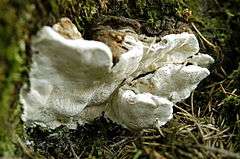Heterobasidion
| Heterobasidion | |
|---|---|
 | |
| Heterobasidion annosum | |
| Scientific classification | |
| Kingdom: | Fungi |
| Division: | Basidiomycota |
| Class: | Agaricomycetes |
| Order: | Russulales |
| Family: | Bondarzewiaceae |
| Genus: | Heterobasidion Bref. (1888) |
| Type species | |
| Heterobasidion annosum (Fr.) Bref. (1888) | |
| Species | |
|
H. abietinum | |
Heterobasidion is a genus of basidiomycetes in the family Bondarzewiaceae. Species in this genus include forest decay fungi that may be pathogenic and cause tree decline and mortality. The genus can be identified from its shelf-like polyporous fruiting bodies. Mating studies in the late twentieth century [1] and genetic studies in the early twenty-first century have described several new species and replacing some of the original names.[2][3] As a result, two former Heterobasidion species, H. annosum and H. insulare, have been expanded into species clusters.
Heterobasidion annosum senso lato
Heterobasidion annosum sensu lato is a collection of species that cause Annosum root rot to forest trees across the Northern Hemisphere. These species can be saprotrophic or necrotrophic, colonizing decayed heartwood or live roots causing mortality. Several tree species have been identified as hosts but evergreen trees such as pine are most affected. Annosum root rot is a serious issue to forest health due to tree mortality, decreased lumber volume and quality, and carbon sequestration.[4] This species cluster is one of the most intensively studied forest pathogens, becoming the first basidiomycete forest pathogen to have its genome sequenced in 2012.[5]
Heterobasidion annosum sensu lato includes five species, based on host preference, genetics, morphology, and location. Sexual mating tests have identified three inter-sterility groups: P, S, and F, named after their chief hosts (pine, spruce, and fir).[1][6] The five species are H. abietinum (F-type), H. annosum senso stricto (P-type), H. irregulare (P-type), H. occidentale (S-type), and H. parviporum (S-type). Genetic analysis have demonstrated the North American species, H. irregulare and H. occidentale, are distinct from each other and the European species within their inter-sterility groups.[2]
Heterobasidion insulare
The H. insulare complex is a taxon of seven Heterobasidion species present in Eastern Asia and India. H. insulare is a saprotrophic decay fungus that is rarely pathogenic. Host species are logs and stumps of evergreen forest species including pine, fir, cedar, and spruce. Some species can be easily differentiated from H. annosum senso lato due to the red colouration on the top of the fruiting body.
Once considered a single species intersterility trials, genetic, and morphological studies have broken it into six distinct species. Sexual mating tests have identified four inter-sterility groups: N, T, Y, and Z.[3][7] The seven species are H. orientale (N-type), H. ecrustosum (T-type), H. insulare sensu typi, H. linzhiense, H. australe, H. amyloideum, H. tibeticum (Z-type).[3][8][9][10]
Heterobasidion araucariae
Heterobasidion araucariae is a saprotrophic decay fungi found in Australia, Oceania, and may be present in Indochina. While not considered pathogenic it can help decay logs and stumps of Agathis, Araucaria, and Pine species.[11]
Other Species
There are three isolates that have been proposed as new species but further description may be necessary.
- Heterobasidion pahangense Corner
- Heterobasidion rutilantiforme (Murrill) Stalpers
- Heterobasidion arbitrarium Corner
References
- 1 2 Korhonen, K. (1978). Intersterility groups of Heterobasidion annosum (Vol. 94, No. 6).
- 1 2 Otrosina, W. J., & Garbelotto, M. (2010). Heterobasidion occidentale sp. nov. and Heterobasidion irregulare nom. nov.: A disposition of North American Heterobasidion biological species. Fungal Biology, 114(1), 16–25.
- 1 2 3 Chen, J. J., Korhonen, K., Li, W., & Dai, Y. C. (2014). Two new species of the Heterobasidion insulare complex based on morphology and molecular data. Mycoscience, 55(4), 289–298.
- ↑ Garbelotto, M., & Gonthier, P. (2013). Biology, epidemiology, and control of Heterobasidion species worldwide. Annual Review of Phytopathology, 51, 39–59.
- ↑ Olson, Å., Aerts, A., Asiegbu, F., Belbahri, L., Bouzid, O., Broberg, A., ... & Stenlid, J. (2012). Insight into trade‐off between wood decay and parasitism from the genome of a fungal forest pathogen. New Phytologist, 194(4), 1001–1013.
- ↑ Capretti, P., Korhonen, K., Mugnai, L., & Romagnoli, C. (1990). An intersterility group of Heterobasidion annosum specialized to Abies alba. European journal of forest pathology, 20(4), 231–240.
- ↑ Dai, Y. C., Vainio, E. J., Hantula, J., NIEMELAe, T., & Korhonen, K. (2002). Sexuality and intersterility within the Heterobasidion insulare complex.Mycological Research, 106(12), 1435–1448.
- ↑ Dai, Y. C., Yu, C. J., & Wang, H. C. (2007, April). Polypores from eastern Xizang (Tibet), western China. In Annales Botanici Fennici (Vol. 44, No. 2, pp. 135–145). Helsinki: Societas Biologica Fennica Vanamo, 1964-.
- ↑ Dai, Y. C., & Korhonen, K. (2009). Heterobasidion australe, a new polypore derived from the Heterobasidion insulare complex. Mycoscience, 50(5), 353–356.
- ↑ Tokuda, S., Hattori, T., Dai, Y. C., Ota, Y., & Buchanan, P. K. (2009). Three species of Heterobasidion (Basidiomycota, Hericiales), H. parviporum, H. orientale sp. nov. and H. ecrustosum sp. nov. from East Asia. Mycoscience, 50(3), 190–202.
- ↑ Buchanan, P. K. (1988). A new species of Heterobasidion (Polyporaceae) from Australasia. Mycotaxon, 32, 325–337.